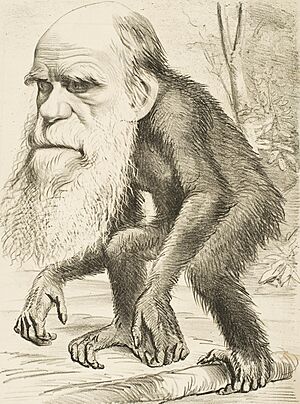Darwinism facts for kids

Darwinism is a term used to describe ideas linked to Charles Darwin's theories about evolution. The meaning of 'Darwinism' has changed over time, and it can mean different things depending on who is using the word.
What Darwinism Means
Darwin's main ideas, which are part of Darwinism, can be summarized like this:
- Within any group of living things, there are natural differences among individuals. Some individuals have differences that are more helpful for survival.
- Even though all species produce many babies, the number of individuals in a group usually stays about the same.
- This happens because individuals of the same species and different species compete for things like food, space, and partners.
- In this struggle to survive, individuals who are not well-suited to their environment often do not make it. The individuals with helpful differences survive and have babies. This idea is called natural selection (or "survival of the fittest").
- Individuals who have these helpful differences pass them on to their children, generation after generation.
- When these helpful differences build up over a very long time, they can lead to the creation of new species.
History of the Term
The word "Darwinism" was first used by Thomas Henry Huxley in April 1860. He used it to talk about ideas of evolution, including similar thoughts like Malthusianism (about population growth) and Spencerism (about "survival of the fittest").
Later, in the late 1800s, "Darwinism" came to mean that natural selection was the only way evolution happened. This was different from Lamarckism, another idea about how living things change.
Around the year 1900, the important work of Gregor Mendel on genetics was rediscovered. Today, Darwin's ideas and Mendel's ideas have been combined. This combination is called the modern evolutionary synthesis. So, the term 'Darwinism' is now often connected to this broader understanding of evolution.
Images for kids
-
Charles Darwin in 1868
See also
 In Spanish: Darwinismo para niños
In Spanish: Darwinismo para niños


